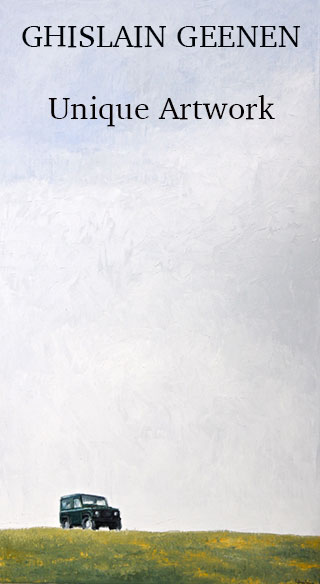Walking the aisles at the Game Fair in July looking at guns isn’t the once-a-year opportunity it used to be.
When I first started visiting Game Fairs (back in the early 1980s) seeing so many gun makers and gun dealers in one row was exciting. Short of driving around the country and visiting each of them in turn, this was the once chance to see what guns they had for sale and it was important to get inside the tent and do a deal before everyone else had seen everything.

Now, pretty much every gun for sale in a gun shop in the UK is listed on Gun Star or Gun Trader, so everything likely to appear on a stand in Gunmaker’s Row has been visible to anyone caring to look on-line for days, weeks or months. It just isn’t as much fun!
Game Fairs have always been a networking hot-spot.
Conversely, the auctioneer’s stands are where it might be possible to see some of the items about to be listed in the next catalogue. Punters still turn up at the Game Fair with gun slips containing things they want valued. Once they get that valuation, some of them will consign to the auction. Drop by periodically and you might se a beaming auctioneer proudly showing off some prized item he has just accepted for sale in a month or two.
Not just a sales or consignment opportunity, Game Fairs have always been a networking hot-spot. This is especially the case now that Holt’s and Gavin Gardiner have stopped offering viewing days in London.
These were once social occasions in themselves, a quarterly meet-up for the gun trade, where dealers, journalists, collectors and agents all got to compare notes and share a bit of trade gossip and banter. They were good days but they are gone.

It is not just that London seemed to lose much of its allure. In-person viewing has been dented by on-line illustrations and condition reports e-mailed on request. We move with the times.
Ragley Hall is good for me. I can ride there on my motorcycle in under and hour and a half. On a sunny summer morning it is a pleasant trip on country A-roads and B-roads, though this year I drove, as I had my niece, Orla, in tow.
These days I don’t bother setting-up a stand, I just make use of the Press facilities and the good nature of my friends and colleagues in the trade, like Rigby, who have rather nice facilities, where a cigar, a camp chair and a cold glass of something combine to finish the day nicely.
One of the subjects always sure to come up is the likely outcome of the latest legislative attack on our trade and our sport. With the Health & Safety Executive pushing for a total ban on all lead projectiles, for all purposes; including clay shooting, rifle ammunition and even air rifle pellets, the issue of what we have that remains viable should non-lead alternatives be required is a hot topic.
Small bore rifles, like .243 may become less attractive to stalkers forced to use non-lead bullets, as they will struggle to meet the minimum bullet weight, velocity and energy requirements for some deer shooting. The fate of the .22 rimfire and its popular subsonic rounds is equally uncertain, if lead is banned.
This could have two major consequences - a dumping of newly useless rifles on the market, through the auctions, and a rush to create viable alternatives which will mimic the performance of popular cartridges by finding a calibre/non-lead projectile combination of rough equivalence.
I covered all this and more during my talk, delivered on Friday and Saturday at the Gun Trade Association stand, where I was followed as a presenter by barrel maker Bill Blacker, auctioneer Gavin Gardiner and Holt’s representative Simon Reinhold.
Despite the scorching heat at Ragley on the Friday, when I found myself inappropriately attired in a new Massy-Birch, three-piece, tweed suit, while everyone else was far more sensibly clad in shorts and T-shirts, attendances for the talks were very good, with almost a full house for mine.
I was grateful for that, there is not much more demoralising than talking to two men and a dog.
Bonham’s had a large stand with plenty to see and a party to boot!
I put on a linen shirt and safari jacket for Saturday. So, naturally it rained! However not with any vigour until after I had left.
Of the auctioneers at the Game Fair, I must say the presence was low key. With one exception, which was Bonham’s. They had a large stand with plenty to see and a party to boot! It was nice to see them flying the flag with such confidence and to see the specialists mingling at various events around the show.
Gavin was there and Holt’s sent personnel around to press the flesh and chat to the trade on their own stands. Cost cutting in lean times has made many auctioneers look long and hard at what is the best place to spend cash on promoting the business and collecting lots for the next sale. Show stands seem to have become a luxury, rather than a necessity in the minds of some.

There are two ways to look at Game Fair stands. the first is as a retail opportunity, where the cost of the stand is weighed precisely against the income generated on the day. The other is as a public relations exercise, spreading the word and the love. As such, sales are a boost.
Word from the trade stands was quite mixed. One London maker had a record day for new orders and sales on the Friday and was delighted with the response of the public. However, dealers with a mixed portfolio were concerned at the lack of interest in new guns as well as the generally depressed level of sales.
One told me he had brought a lot of used Brownings and Mirokus; guns that he would usually expect to sell fast and furiously at competitive prices at the Game Fair, however he reported little interest from punters.
Interesting English guns and rifles are still getting attention but they have to be good, unusual and priced right. Generally, the prices for British guns are low and demand has fallen off a cliff.
collectors who are now selling are being disappointed at the prices
As always, the best guns in the best condition will hold onto value hardest but, as Gavin Gardiner pointed-out in his talk at the GTA, the prices of even best Purdey side-locks and Boss over & unders are the same as they were thirty years ago.
A lot of collectors who are now selling are being disappointed at the prices they are offered for guns they thought they had bought as investments.
While it is nice to be involved in a confident, rising market, we should recognise that auctioneers can also make money in a falling market, as they get paid if the gun sells, regardless of the loss the seller makes. However, in order to sell, it has to be priced right. Holt’s seem to be doing that, having turned over £1.7 Million in July.

Where is all this heading? I don’t think anybody really knows. One doleful dealer on Gunmaker’s Row said he had never known the market so bad.
2022 figures show a 5% decrease in the number of shotgun licences held in England & Wales. if we round the number down to 500,000 licence holders and lose 5% of them, that is 25,000 giving up their guns. If every one of them has an average five guns, that means 125,000 guns arrived on the market in the last twelve months. Where are they and who is buying them?
As winter looms and heating costs overtake discretionary spend, how well will the Trade react? Auctioneers have always done well selling into markets where the economy is strong when a previously good market softens.
We can be sure Texan oilmen will be ‘holding folding’ in abundance as the rest of us suffer in the cold but is the emerging generation interested in old guns? I guess we are about to find out.
Published by Vintage Guns Ltd on (modified )




